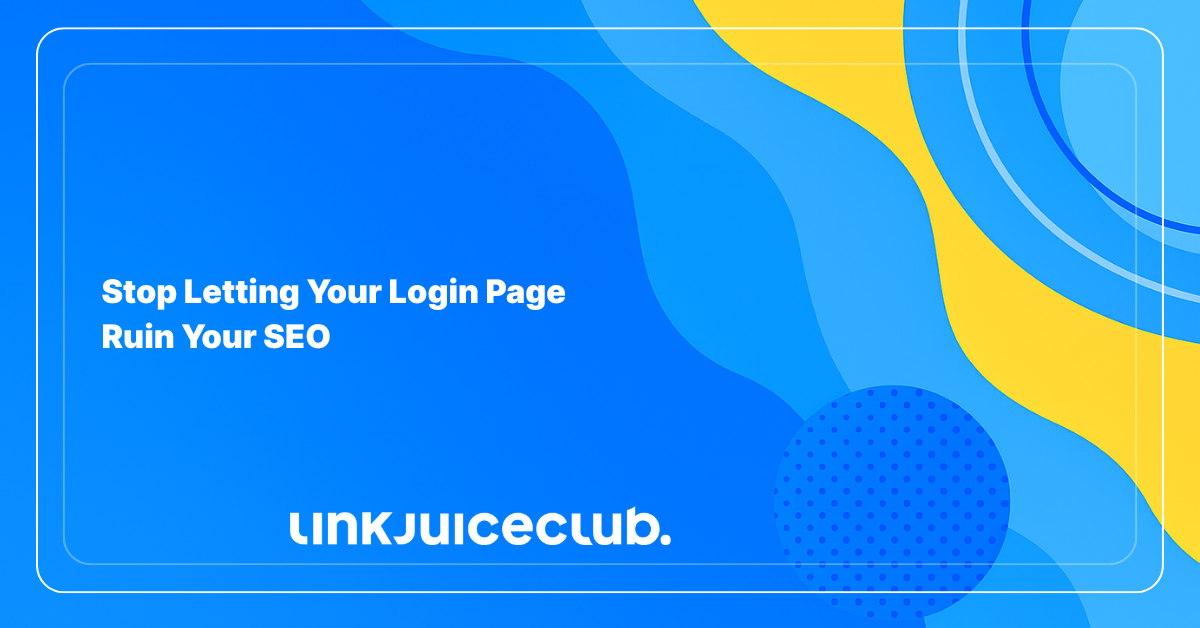
Stop Letting Your Login Page Ruin Your SEO
No one likes hitting a login wall when they’re just trying to learn more about your site. But what’s annoying for users is even worse for search engines. If your login pages are confusing, overused, or blocking important content, they could be dragging down your entire SEO performance.

Why Login Pages Can Wreck Your Rankings (Without You Even Realizing)
Google’s bots are on the hunt for helpful content. So when they reach a page that says log in to continue and nothing else, that’s a dead end. And dead ends don’t rank.
Think about it: if someone searches your brand or a topic you cover, clicks your link, and all they get is a login screen, what do they do? They bounce. Fast. And search engines track that kind of thing. A high bounce rate and lack of accessible content tell Google your site isn’t meeting user intent. That’s a red flag for rankings.
The problem gets worse when every private section of your site leads to the same login page. Crawlers see the repetition and assume there’s nothing unique to index.
A quick fix is to rethink your login experience. Add teasers, summaries, or previews on gated pages. Give search engines (and users) something to work with before asking for credentials. Treat your login not as a guided entry point. Make it part of the journey, not a frustrating dead stop.
When Every Login Page Looks the Same, Google Gets Confused
Duplicate content isn’t just about blog posts. If all your gated pages (dashboards, member areas, premium tools) funnel into the same bland login screen, search engines start seeing echoes instead of value.
To bots, it looks like one page copied a hundred times, and that’s a recipe for getting buried.
So, mix it up! Customize those entry points so each serves a unique purpose. Add tailored previews, short intros, or even different headings. When pages look distinct, crawlers understand what’s worth indexing and humans appreciate the clarity too.
Make Your Login Screens Actually Useful
Your login page doesn’t have to be a dead end. Instead of showing users a plain wall, use that space to highlight what’s behind the gate.
Add a short, punchy overview of what they’ll get: exclusive tools, member-only content, or premium perks.
This quick preview helps people understand why they should log in, and it also gives search engines something to chew on. Don’t clutter it, keep it simple, visual, and fast. A little context goes a long way.
Use Structured Data to Explain What’s Locked
Gated content doesn’t have to be invisible. By adding structured data (yep, the schema kind), you can tell Google that content exists, but requires a login.
This allows the search engine to show a teaser or snippet, which can improve clicks without exposing the full content.
It works for paid content, member-only sections, and even internal dashboards. All you need is the right metadata to flag what’s hidden and what’s visible. It’s a small step with big upside: better previews, better targeting, better SEO.
Run Real Tests and Fix What’s Broken
Don’t guess – test. Open an incognito tab and Google your site. Do you land on login prompts instead of helpful pages? That’s a red flag.
Use tools like Google Search Console to see what’s being indexed, and cross-check it with your site’s structure.
Watch for weird redirects, blank search snippets, or URLs that lead nowhere. Then fix them, redirect smartly, noindex where needed, and make your login pages more informative. A little cleanup can go a long way in making sure your gated content plays nice with SEO.
Visibility Doesn’t Have to End at the Login Screen
In a world where gated content is the norm, your SEO shouldn’t take the hit. By treating login pages as part of the user journey (not a dead end) you can balance privacy with performance. With smart structure, metadata, and user-focused design, even private spaces can support your search visibility.
If you future-proof your setup with flexible access rules, cross-team collaboration, and a willingness to tweak and test, you’ll build a site that’s both secure and searchable. And that’s the sweet spot where great user experience meets great rankings.





